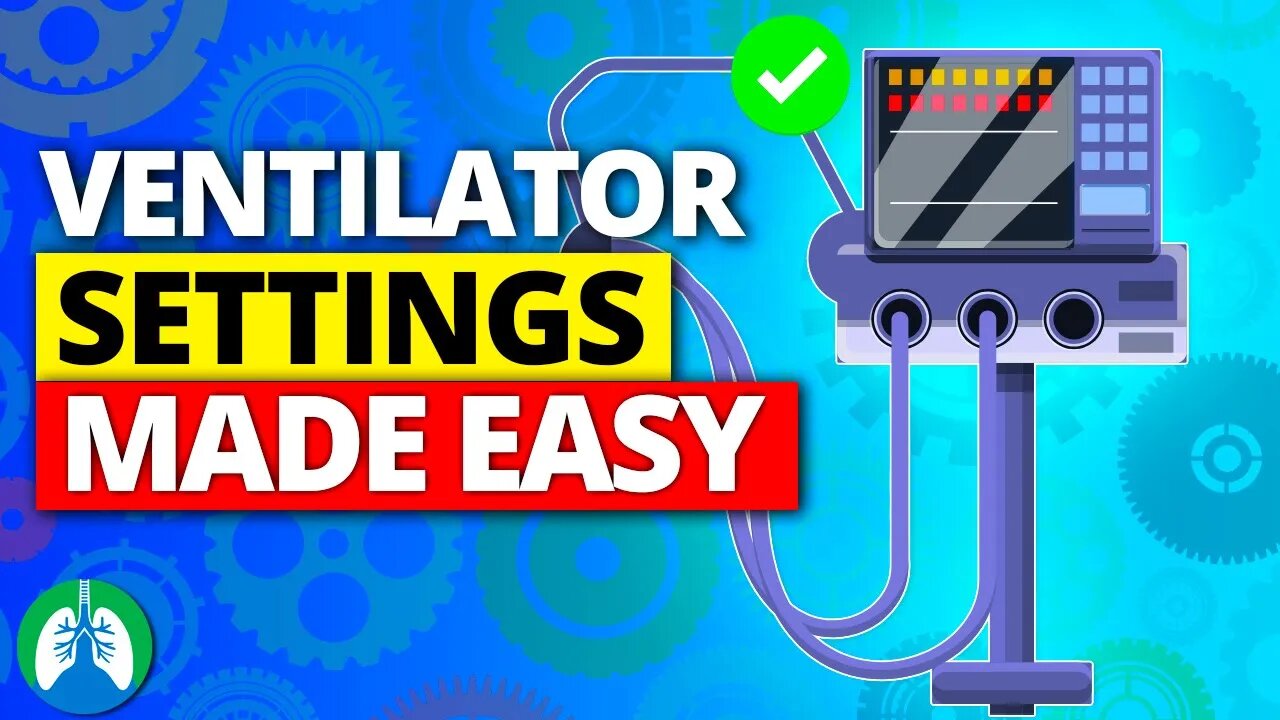Premium Only Content

Ventilator Settings Explained (Mechanical Ventilation Modes Made Easy)
This video breaks down all of the Ventilator Settings in a simple way. Mechanical Ventilator Modes Made Easy! Watch the video to learn more.
💥Ventilator Settings [Full Guide] ➜ ➜ ➜ https://bit.ly/2KMrNle
➡️ What are Ventilator Settings?
To give a brief definition, ventilator settings are the controls on a mechanical ventilator that can be set or adjusted in order to determine the amount of support that is delivered to the patient.
➡️ Ventilator Mode
Essentially, a ventilator mode is a way of describing how the mechanical ventilator assists a patient with inspiration. The characteristics of a particular mode control how the ventilator functions.
➡️ Tidal Volume
Tidal Volume refers to the volume of air that is inhaled and exhaled from the lungs during normal breathing. The tidal volume setting on the ventilator determines how much air is delivered to the lungs by the machine.
➡️ Frequency (Respiratory Rate)
Or, it can even be referred to as the breathing rate because this setting simply controls the rate at which breathing occurs. It typically refers to the number of breaths that are taken per minute and the normal range is: 10-20 breaths/min.
➡️ Fraction of Inspired Oxygen (FiO2)
This refers to the concentration of oxygen that is being inhaled by the patient. For patients with severe hypoxemia, an FiO2 of 100% may be required when mechanical ventilation is initiated. But your goal as a Respiratory Therapist should be to wean the FiO2 down to the lowest possible level that still provides adequate oxygenation.
➡️ Flow Rate
This setting controls how fast a tidal volume is delivered to the patient by the ventilator. The setting can be adjusted depending on the patient’s inspiratory demands. The normal inspiratory flow rate should be set at around: 60 L/min.
➡️ Inspiratory-to-Expiratory Ratio (I:E Ratio)
It refers to a ratio of the inspiratory portion compared to the expiratory portion of the breathing cycle. For patients on the ventilator, the normal I:E ratio is between 1:2 and 1:4. A larger I:E ratio may be delivered if a patient is in need of a longer expiratory time due to the possibility of air trapping.
➡️ Trigger Sensitivity
The sensitivity control is what determines how much effort the patient must generate in order to trigger a breath from the machine. And when I say effort, what I'm really referring to is how much negative pressure the patient must generate for the ventilator to deliver a breath.
➡️ Positive End Expiratory Pressure (PEEP)
PEEP is essentially an amount of positive pressure that is delivered during the expiratory phase of the breathing cycle. It helps prevent the closure of alveoli in the lungs which allows an increased amount of time for oxygen exchange to occur.
➡️ Ventilator Alarms
A ventilator alarm is a safety mechanism on the machine that uses set parameters to provide alerts whenever there is a potential problem related to the patient-ventilator interaction.
💥Ventilator Settings [Full Guide] ➜ ➜ ➜ https://bit.ly/2KMrNle
—————
📗 BEST STUDY GUIDES FOR YOU
▪ TMC Test Bank 👉 http://bit.ly/2IGeqSu
▪ Hacking the TMC Exam 👉 http://bit.ly/2XBc8do
▪ TMC Exam Bundle (Save $) 👉 https://bit.ly/34pqEsV
▪ Daily TMC Practice Questions 👉 http://bit.ly/2NnXh3C
💙MORE FROM RTZ
▪ Free TMC Practice Exam 👉 http://bit.ly/2XlwASL
▪ Free RRT Cheat Sheet 👉 http://bit.ly/2IbmOKB
▪ Resources for RT's 👉 http://bit.ly/2WVV5qo
▪ Testimonials 👉 http://bit.ly/2x7b5Gl
🌐FOLLOW US
▪ Instagram 👉 http://bit.ly/2FhF0jV
▪ Twitter 👉 http://bit.ly/2ZsS6T1
▪ Facebook 👉 http://bit.ly/2MSEejt
▪ Pinterest 👉 http://bit.ly/2ZwVLPw
🚑MEDICAL DISCLAIMER
Medicine and Respiratory Therapy are continuously changing practices. The information in this video is for educational and entertainment purposes only. For medical advice, please consult with a physician or qualified medical professional.
💡AFFILIATE DISCLAIMER
This description contains affiliate links. If you decide to purchase a product through one of them, we receive a small commission at no cost to you.
—————
⏰TIMESTAMPS
0:00 - Intro
0:54 - What are Ventilator Settings?
1:59 - Ventilator Mode
3:15 - Tidal Volume
3:52 - Frequency (Respiratory Rate)
4:23 - Fraction of Inspired Oxygen (FiO2)
5:02 - Flow Rate
5:57 - Inspiratory-to-Expiratory Ratio (I:E Ratio)
6:39 - Trigger Sensitivity
7:42 - Positive End Expiratory Pressure (PEEP)
8:47 - Ventilator Alarms
—————
🖼CREDIT FOR GRAPHICS:
▪ Graphics: www.canva.com
▪ Graphics: www.freevector.com
▪ Graphics: www.vecteezy.com
▪ Graphics: www.pngtree.com
#MechanicalVentilation #VentilatorSettings #VentilatorModes #RespiratoryTherapy #RespiratoryTherapist #RespiratoryTherapySchool
-
 3:23
3:23
Respiratory Therapy Zone
11 months agoSickle Cell Anemia *Quick Explainer Video* 🩸
526 -
 LIVE
LIVE
Hevel Gaming
6 hours ago $1.26 earnedNCAAF Tennessee at Georgia While with Heroes of Might and Magic III & Helldivers 2
2,092 watching -
 LIVE
LIVE
MissesMaam
4 hours agoI'm Addicted | Sons of the Forest 💚✨
1,032 watching -
 LIVE
LIVE
a12cat34dog
6 hours agoALMOST HAVE ALL GUNS DIAMOND :: Call of Duty: Black Ops 6 :: SO MANY ZOMBIES CAMOS {18+}
813 watching -
 LIVE
LIVE
United Fight League
7 hours agoUFC 309 Watch Party w/ Rampage Jackson, Maycee Barber, Demi Bagby, and Harrison Rogers
3,062 watching -
 2:35:52
2:35:52
Jewels Jones Live ®
1 day agoELECTION OVER - LIES CONTINUE | A Political Rendezvous - Ep. 100
14.4K29 -
 3:59:18
3:59:18
GamerGril
9 hours agoPAGING ALL ZOMBOIZ | DEAD ISLAND 2
62.9K7 -
 42:24
42:24
MYLUNCHBREAK CHANNEL PAGE
17 hours agoA Century Gone
111K55 -
 38:22
38:22
Stephen Gardner
10 hours ago🔥HOLD ON! The RUMORS about Kamala are TRUE...
156K396 -
 1:22:44
1:22:44
Michael Franzese
1 day agoWill Trump’s Win Finally Convince Democrats to Stop The Woke Nonsense??
150K110